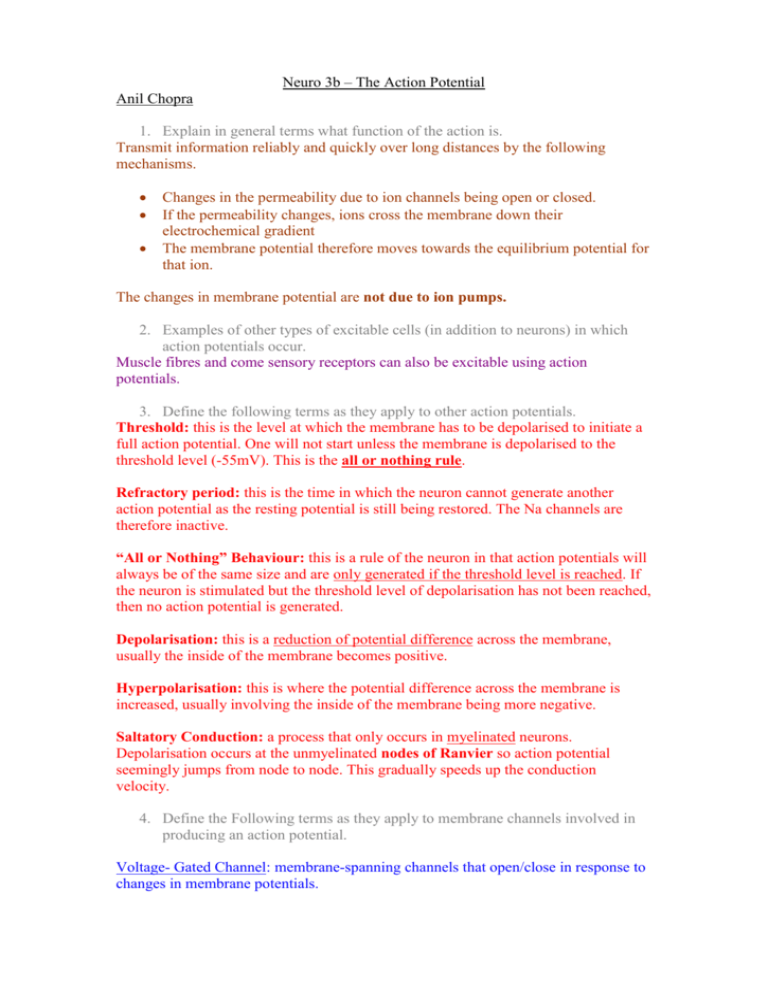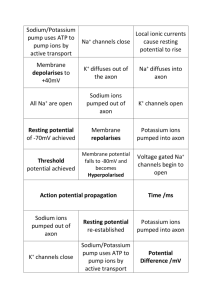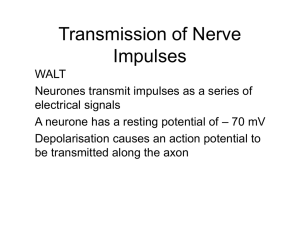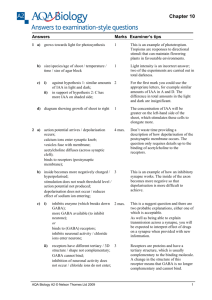Neuroscience 3b – The Action Potential
advertisement

Neuro 3b – The Action Potential Anil Chopra 1. Explain in general terms what function of the action is. Transmit information reliably and quickly over long distances by the following mechanisms. Changes in the permeability due to ion channels being open or closed. If the permeability changes, ions cross the membrane down their electrochemical gradient The membrane potential therefore moves towards the equilibrium potential for that ion. The changes in membrane potential are not due to ion pumps. 2. Examples of other types of excitable cells (in addition to neurons) in which action potentials occur. Muscle fibres and come sensory receptors can also be excitable using action potentials. 3. Define the following terms as they apply to other action potentials. Threshold: this is the level at which the membrane has to be depolarised to initiate a full action potential. One will not start unless the membrane is depolarised to the threshold level (-55mV). This is the all or nothing rule. Refractory period: this is the time in which the neuron cannot generate another action potential as the resting potential is still being restored. The Na channels are therefore inactive. “All or Nothing” Behaviour: this is a rule of the neuron in that action potentials will always be of the same size and are only generated if the threshold level is reached. If the neuron is stimulated but the threshold level of depolarisation has not been reached, then no action potential is generated. Depolarisation: this is a reduction of potential difference across the membrane, usually the inside of the membrane becomes positive. Hyperpolarisation: this is where the potential difference across the membrane is increased, usually involving the inside of the membrane being more negative. Saltatory Conduction: a process that only occurs in myelinated neurons. Depolarisation occurs at the unmyelinated nodes of Ranvier so action potential seemingly jumps from node to node. This gradually speeds up the conduction velocity. 4. Define the Following terms as they apply to membrane channels involved in producing an action potential. Voltage- Gated Channel: membrane-spanning channels that open/close in response to changes in membrane potentials. Channel Inactivation: this is when a gate blocks the Na channels in repolarisation and the absolute refractory period. It stops any more Na from entering the cell. Positive feedback: this is what occurs when the threshold level is reached. As the membrane becomes depolarised, Na channels open, Na ions flood in which cause more depolarisation. 5. Outline the sequence of events during a typical action potential in a neuron. Equilibrium potential for Na 4) Resting potential 5) Hyperpolarisation 3) Upstroke Phase 2) Stimulus/Foot 1) Resting potential Equilibrium potential for K (1) Resting Potential – Membrane permeable to K+ but impermeable to Na+ so membrane potential is close to that of K+ (-90mv). It is -70mV. (2) Stimulus/Foot – stimulus slightly depolarises membrane to threshold level. (3) Upstroke Phase – voltage gated Na channels open and membrane becomes permeable to Na+ ions. Na+ ions flux in down their concentration gradient. (4) Repolarisation phase - voltage gated Na channels inactivate so Na entry stops. K+ channels open so K+ ions flow out of the causing membrane potential to go down to that of K+. (5) Hyperpolarisation – K+ channels still open so that K+ ions still leaving cell until gates close and resting potential in restored. 6. State the size and duration of a typical action potential. Size: from -70mV up to +30mV Duration: around 4 milliseconds 7. Define the term regenerative as applied to action potentials and its significance for the spread of the potential along the axon. Regenerative: more and more Na channels keep opening and Na+ ion entering the axon until the depolarisation reaches a point where the voltage-gated Na+ channels inactivate and become voltage insensitive. This allows the K+ gates to open and so the membrane regenerates its polarised state. As the action potential travels in one direction only as the regions behind them are in absolute refractory period. 8. Explain how conduction of the action potential occurs (conduction here means spread along the axon/transmission propagation) Local current flow depolarizes adjacent region toward threshold Active area at peak of action potential Direction of propagation of action potential Remainder of axon at resting potential Adjacent area at resting potential The depolarisation spreads along the axon by Na+ ions enter the cell and K+ ions leaving. Only a small number of ions cross causing a 0.1% concentration change. The current that is initiated induces depolarisation in the part of the axon just after (adjacent) to it. Just behind the action potential, the region returns to resting potential with the help of the Na+/K+ ion pump. 9. List two structural features that affect the conduction velocity along normal axons. Briefly explain why they affect velocity as they do. Velocity affected by… Myelination: increases the speed by saltatory conduction. The depolarisation only occurs at the nodes of Ranvier and so the action potential can jump from node to node. Axon diameter: the larger the diameter, the less resistance there is to the flow of the action potential. Large diameter myelinated axon 120m/s Small diameter unmyelinated axon 1m/s Local current flow depolarizes new adjacent region toward threshold New active area at peak of action potential Old active region returning to resting potential New adjacent area at resting potential 10. List at least one pathological condition that affects conduction velocity. - Cold - Multiple - Sclerosis - Anoxia - Some drugs






